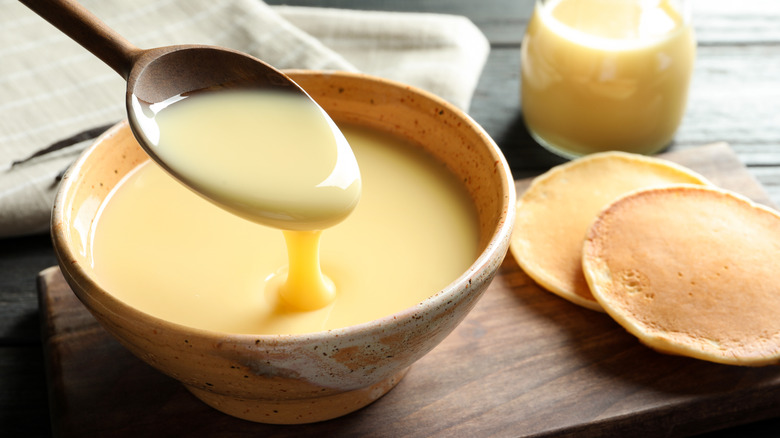How Sweetened Condensed Milk Is Actually Made
On its surface, the idea of milk that doesn't need refrigeration seems suspicious. And if you crack open a can of sweetened condensed milk, you might find its contents less than appealing at first glance. Bon Appétit describes sweetened condensed milk as "weirdly thick and sticky" and likens its appearance to Elmer's glue.
But while it may make an off-putting first impression, sweetened condensed milk provides a balanced blend of creaminess and sweetness that makes it versatile. It's an essential ingredient in flan, key lime pie, and tres leches cake, among many other desserts.
According to The National Inventors Hall of Fame, this sweet ingredient was born from tragedy. An American named Gail Borden Jr. took a trip by steamship where he witnessed multiple children die from consuming spoiled milk. He became determined to create shelf-stable milk and ultimately invented condensed milk in 1853. Per McGill University, Borden's business struggled for a decade, until the Civil War brought condensed milk to national prominence. The United States government purchased it in bulk to use as field rations, and it quickly caught on with soldiers. More than 150 years later, the Borden company is still in business, and sweetened condensed milk is a pantry staple in many homes.
What is sweetened condensed milk?
Sweetened condensed milk is made by heating fresh milk until most of the water within it has evaporated, then canning it for preservation. According to Food Network, it is standard for condensed milk to have 60% of its original water content removed in this fashion, giving it its characteristic viscosity. Like most fresh milk, condensed milk is homogenized, and it comes in whole, low-fat, and skim varieties.
A can of sweetened condensed milk can keep for over a year (unopened, that is). It can sometimes have a light brown color, which is perfectly normal, but if you open a can and see a dark brown or yellow liquid, you should throw it out. Just like fresh milk, condensed milk can curdle and take on a bad smell when it goes bad. But while it won't last indefinitely, it still has astounding staying power for a dairy product.
The second part of making sweetened condensed milk is adding the sweet factor in the form of sugar — and a lot of it. According to Food Network, sweetened condensed milk is typically 40-45% sugar. The obvious benefit here is that it sweetens the mixture and makes it an excellent additive to desserts, but there's more to it than that. Bon Appétit explains that the sugar also extends the milk's shelf life by preventing certain microorganisms from growing in it. The sugar is added after the evaporation process.
Condensed milk vs. evaporated milk
With all this talk about evaporation, you might be wondering whether evaporated milk is any different from sweetened condensed milk. While they aren't exactly the same, the difference between these two products is simple.
Food Network explains that both sweetened condensed and evaporated milk have approximately 60% of their water content removed by evaporation. But unlike condensed milk, the evaporated variety has no added sugar. Therefore, the term "sweetened condensed milk" is redundant; there's no such thing as unsweetened condensed milk. It would be more accurate, and much simpler, to call it "sweetened evaporated milk," but humans can't help ourselves from complicating things, can we?
Food Network says you can substitute evaporated milk for sweetened condensed milk in some cases, although it's not the most convenient option. Because they have the same amount of water evaporated from them, they should have the same consistency. Of course, if you're using evaporated milk in place of condensed milk, you'll need to add extra sugar to your recipe, but it doesn't work in all cases. The sugar in condensed milk gets highly concentrated during the canning process, giving it a distinct caramelized flavor that you can't get by just adding sugar to evaporated milk. On the other hand, you shouldn't use condensed milk in a recipe that calls for evaporated milk; it will add unwanted sugar to the dish.


